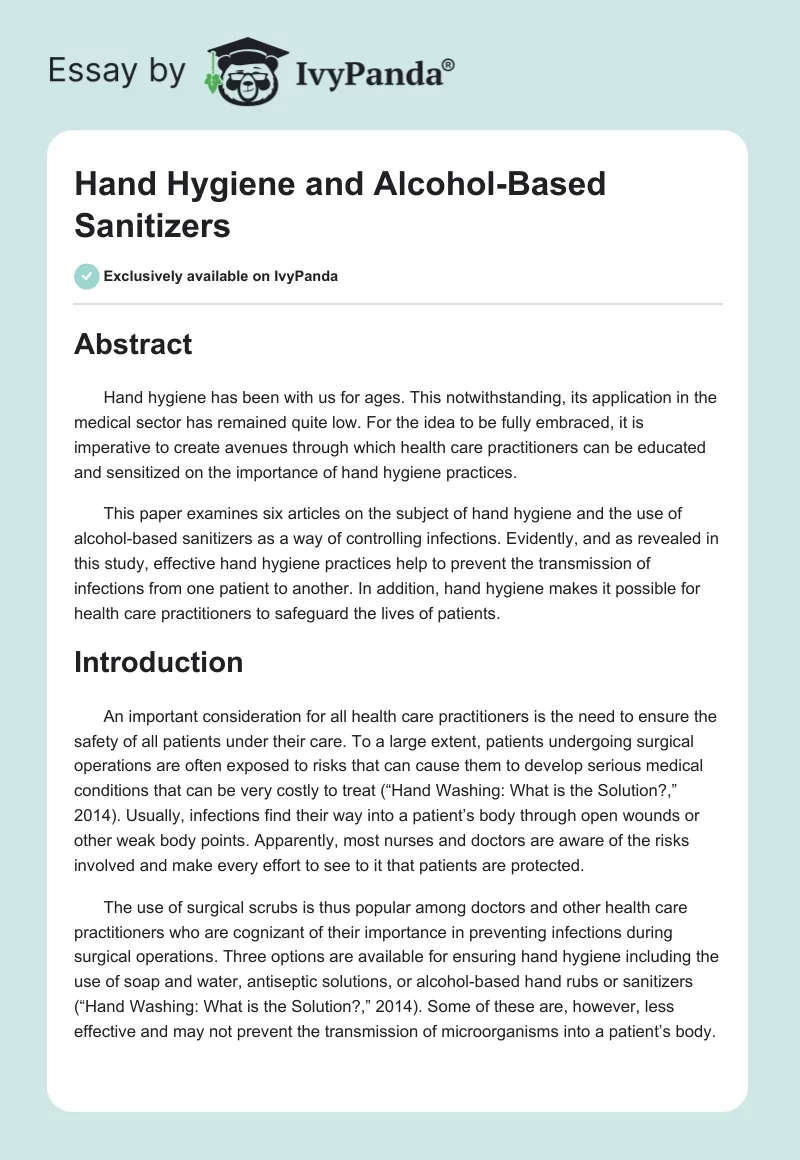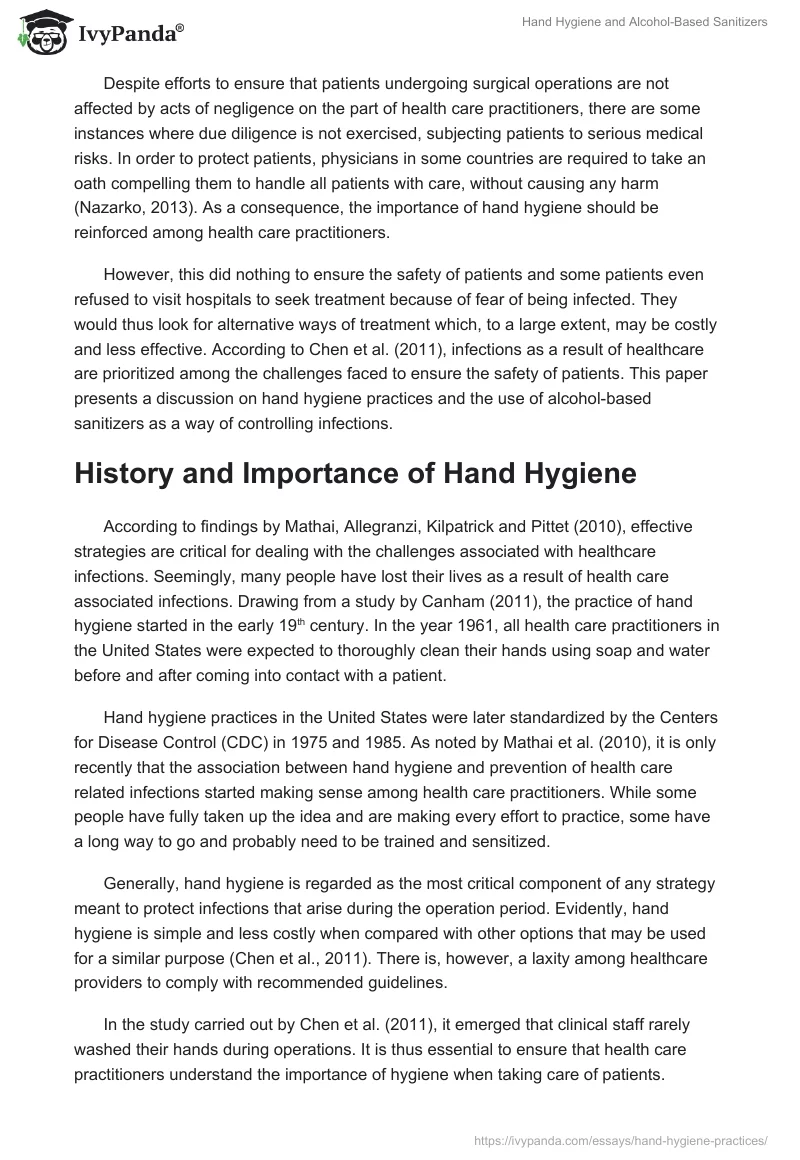Abstract
Hand hygiene has been with us for ages. This notwithstanding, its application in the medical sector has remained quite low. For the idea to be fully embraced, it is imperative to create avenues through which health care practitioners can be educated and sensitized on the importance of hand hygiene practices.
This paper examines six articles on the subject of hand hygiene and the use of alcohol-based sanitizers as a way of controlling infections. Evidently, and as revealed in this study, effective hand hygiene practices help to prevent the transmission of infections from one patient to another. In addition, hand hygiene makes it possible for health care practitioners to safeguard the lives of patients.
Introduction
An important consideration for all health care practitioners is the need to ensure the safety of all patients under their care. To a large extent, patients undergoing surgical operations are often exposed to risks that can cause them to develop serious medical conditions that can be very costly to treat (“Hand Washing: What is the Solution?,” 2014). Usually, infections find their way into a patient’s body through open wounds or other weak body points. Apparently, most nurses and doctors are aware of the risks involved and make every effort to see to it that patients are protected.
The use of surgical scrubs is thus popular among doctors and other health care practitioners who are cognizant of their importance in preventing infections during surgical operations. Three options are available for ensuring hand hygiene including the use of soap and water, antiseptic solutions, or alcohol-based hand rubs or sanitizers (“Hand Washing: What is the Solution?,” 2014). Some of these are, however, less effective and may not prevent the transmission of microorganisms into a patient’s body.
Despite efforts to ensure that patients undergoing surgical operations are not affected by acts of negligence on the part of health care practitioners, there are some instances where due diligence is not exercised, subjecting patients to serious medical risks. In order to protect patients, physicians in some countries are required to take an oath compelling them to handle all patients with care, without causing any harm (Nazarko, 2013). As a consequence, the importance of hand hygiene should be reinforced among health care practitioners.
However, this did nothing to ensure the safety of patients and some patients even refused to visit hospitals to seek treatment because of fear of being infected. They would thus look for alternative ways of treatment which, to a large extent, may be costly and less effective. According to Chen et al. (2011), infections as a result of healthcare are prioritized among the challenges faced to ensure the safety of patients. This paper presents a discussion on hand hygiene practices and the use of alcohol-based sanitizers as a way of controlling infections.
History and Importance of Hand Hygiene
According to findings by Mathai, Allegranzi, Kilpatrick and Pittet (2010), effective strategies are critical for dealing with the challenges associated with healthcare infections. Seemingly, many people have lost their lives as a result of health care associated infections. Drawing from a study by Canham (2011), the practice of hand hygiene started in the early 19th century. In the year 1961, all health care practitioners in the United States were expected to thoroughly clean their hands using soap and water before and after coming into contact with a patient.
Hand hygiene practices in the United States were later standardized by the Centers for Disease Control (CDC) in 1975 and 1985. As noted by Mathai et al. (2010), it is only recently that the association between hand hygiene and prevention of health care related infections started making sense among health care practitioners. While some people have fully taken up the idea and are making every effort to practice, some have a long way to go and probably need to be trained and sensitized.
Generally, hand hygiene is regarded as the most critical component of any strategy meant to protect infections that arise during the operation period. Evidently, hand hygiene is simple and less costly when compared with other options that may be used for a similar purpose (Chen et al., 2011). There is, however, a laxity among healthcare providers to comply with recommended guidelines.
In the study carried out by Chen et al. (2011), it emerged that clinical staff rarely washed their hands during operations. It is thus essential to ensure that health care practitioners understand the importance of hygiene when taking care of patients. Despite being helpful for improving the safety of patients, hand hygiene also lessens the burden of caring for patients and reduces the overall associated cost.
The importance of hand hygiene springs from the fact that infections are normally passed from one patient to another through the hands of health care practitioners (Nazarko, 2013). Ostensibly, this is because human hands are prone to contamination by microorganisms which can easily be transmitted from one patient to another by health care practitioners. However, they usually do not pose a big threat unless an individual has a skin that is damaged or has a weak immune system.
Evidently, effective hand washing can help to drastically lower the rate of infection. For this reason, health care practitioners should understand the benefits associated with hand hygiene practices. Ideally, recommended guidelines for hand hygiene practices should be followed keenly by all health care practitioners as they attend to patients.
Hand Hygiene Practices and the Use of Alcohol-Based Sanitizers
Citing the challenges associated with hand hygiene, alcohol-based hand rubs or sanitizers were introduced. For sometime, however, some people felt that alcohol-based sanitizers could not be used in places where sinks were lacking. Subsequent guidelines by Centers for Disease Control cleared the confusion by advocating for the use of alcohol-based hand rubs to clean hands before and after any surgical procedure.
In general, the use of alcohol-based hand rubs or sanitizer was meant to reduce instances of infections during operations as a result of health care practitioners failing to clean their hands properly. Ordinarily, alcohol-based hand rubs play an important role in preventing micro-organisms from being passed from one patient to another through the health care practitioners’ hands. In the study by Chen et al. (2011), they made use of a quasi experimental study design that involved the close monitoring of health care associated infections in order to determine the effectiveness of hand hygiene using alcohol-based hand rubs.
Based on their study, strict adherence to hand hygiene was found to be less costly. Besides, adherence to hand hygiene seemed to help with the reduction of health care associated infections. Apparently, some concerns have been raised regarding the use of alcohol based solutions. Although findings from different studies point to the fact that alcohol based solutions are more effective in dealing with microorganisms unlike the use of soap and water, they tend to have a less powerful effect on some viruses such as rotavirus as well as on some bacteria such as clostridium difficile (“Hand Washing: What is the Solution?,” 2014). As a result, the use of alcohol based solutions when dealing with patients with such infections should be encouraged.
While comparing the effectiveness of different hand hygiene solutions, Canham (2011) argued that while the use of plain soap and water is good, antimicrobial soap presents a better solution. However, the use of alcohol based hand rubs offers the best solution. It is worthwhile noting that the use of alcohol based sanitizers is inappropriate where hands are soiled or contaminated. The effectiveness of alcohol based solutions also depends on the percentage of alcohol used. Bacteria are better destroyed by alcohol based solutions that contain between 60 and 95 percent alcohol.
According to Stephen-Haynes (2014), health care practitioners can use various approaches to prevent infection. Using antimicrobial therapy, for example, it is possible for nurses and doctors to eliminate the possibility of infections being transmitted from patient to patient. The patient may also be safeguarded through immunization and personal hygiene. It is also advisable for health care practitioners to use the correct clinical equipment and protective clothing for the sake of patients.
Arguably, a patient’s personal hygiene also plays an important role in preventing the spread of microorganisms (Stephen-Haynes, 2014). Consequently, efforts should be made to ensure that patients take a bath on a regular basis. Health care practitioners should also ensure that patients do not share personal hygiene items such as toothbrushes and towels. In some cases, nurses are required to use different clothes to clean different parts of a patient’s body. In addition, it is necessary for every patient to have his or her own bowl.
The effectiveness of hand hygiene depends on proper selection of hand hygiene products. Moreover, the procedure to be undertaken and the extent of contamination also affect the success of hand hygiene to some extent. Accordingly, health care practitioners must take time to carefully choose the best products to be used for sanitization. In general, the articles reviewed indicate that alcohol-based sanitizers are more effective. While this may be true, there are concerns that alcohol based sanitizers are limited in some ways and may fail to produce the desired results in some cases.
Conclusion
Following from the discussion presented in this paper, it is obvious that hand hygiene plays a very important role in ensuring the safety of patients. Throughout the world, many people have lost their lives as a result of health care related infections and it is thus imperative for health care practitioners to be familiar with different mechanisms for dealing with such challenges. As suggested by various authors, health care practitioners should consider having guidelines for effective hand hygiene.
Although it appears like a simple problem, many people may lose their lives due to negligence and lack of knowledge among health care practitioners. However, it is possible to control the damage caused by health care related infections and stakeholders should come together and devise effective intervention strategies. As earlier explained, guidelines should be provided to ensure that health care practitioners adhere to best practices. In most cases, having guidelines in place is usually meant to ensure that all those taking care of patients get to do what is expected of them.
Arguably, the idea of hand hygiene seems to be a foreign one to some health care practitioners. As a consequence, health care practitioners should be trained and sensitized on the need for effective hand hygiene. Efforts should be made to encourage health care practitioners to embrace the concept of hand hygiene in order to improve the safety of patients. In addition, guidelines should be provided to health care practitioners to guide them on ensuring the effectiveness of hand hygiene in the medical sector. In the absence of such guidelines, there is a likelihood that health care practitioners will use their own judgment which may lead to serious problems.
References
Canham, L. (2011). The First Step in Infection Control is Hand Hygiene. Dental Assistant, 80(1), 42 – 46.
Chen, Y., Sheng, W., Wang, J., Chang, S., Tien, K., Hsu, L., Tsai, K. & Lin, H. (2011). Effectiveness and Limitations of Hand Hygiene Promotion on Decreasing Healthcare–Associated Infections. PLoS ONE, 6(11), 1 – 9.
Hand Washing: What is the Solution? (2014). Journal of Perioperative Practice, 3(2), 8 – 10.
Mathai, E., Allegranzi, B., Kilpatrick, C. & Pittet, D. (2010). Prevention and Control of Health Care-Associated Infections through Improved Hand Hygiene. Indian Journal of Medical Microbiology, 28(2), 100 – 106.
Nazarko, L. (2013). Putting Patient Safety at the Heart of Healthcare. British Journal of Healthcare Management, 19(9), 422 – 427.
Stephen-Haynes, J. (2014). How to Ensure Better Infection Control in the Patient’s Home. Journal of Community Nursing, 28(3), 76 – 80.


